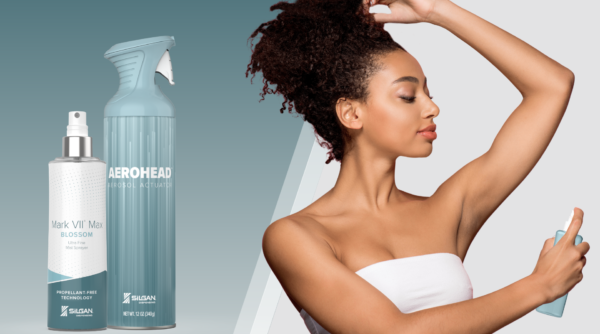
In the consumer-packaged goods (CPG) space, having a diverse product portfolio allows brands to serve an equally wide range of consumer needs. Offering both aerosol and propellant-free sprayers is a great example of leveraging different product technologies to extend the reach of consumer preference in spray performance. Both provide distinct advantages, and with fine-mist sprayers, the technology continues to evolve in a way that offers notable performance and sustainability benefits.
Silgan Dispensing continues to add propellant-free solutions to our portfolio, including our latest offering, Mark VII® Max Blossom. We recently met with Etienne Briere, Senior Manager, Global Fine Mist, Foam, and EU Aerosol, 2cc Dispenser, to discuss the development of Mark VII® Max Blossom and why more consumers are seeking out fine-mist substitutes for aerosol-based products.
What led to the creation of Mark VII® Max Blossom? What market or customer needs and trends were Silgan Dispensing aiming to address with this product?
Brands are exploring aerosol alternatives as dispensing needs evolve in spray. Non-aerosols, like Mark VII® Max Blossom, are easier to travel with on airplanes and can be refilled, which speaks to a growing sustainability want. Additionally, we’re seeing more consumers gravitate toward products with formulations that use natural ingredients. Adding a propellant like hydrocarbons or compressed gases, which may emit VOCs into the atmosphere, to a product highlighting natural ingredients often negates the sustainability benefit for many.
Tell us about the design process, what was it like?
The main challenge was to develop a fine-mist sprayer with the performance more closely resembling that of an aerosol; meaning, it had a long actuation spray, a generous output, and the capability to spray very small droplets for a dry effect in contact with skin.
We also needed to ensure it could be manufactured in a way that didn’t adversely impact its cost structure, relative to aerosol products. We went through multiple iterations, combining our pump engines with the different spray insert technologies, in order to achieve a balance between cost structure and spray performance targets.
Tell us about the sustainability considerations for non-aerosols like Mark VII® Max Blossom.
This gets back to the impetus of its creation. It’s non-aerosol design removes propellants, simplifies the filling process, and enables the use of refills.
How is Mark VII® Max Blossom comparable to an aerosol spray? How is it different?
The difference is more in the actuation. Mark VII® Max Blossom offers a long actuation versus the continuous one you experience with aerosols. In some ways, longer actuation can create a premium experience, as it’s an actuation style more commonly seen with luxury products. With Blossom, we aim to offer such premium experience through a more affordable solution.
What kinds of formulations or applications are better suited for non-aerosols?
Non-aerosols like Blossom are particularly efficient for liquid formulas. For instance, we have measured great performance combining Blossom with the new generation of deodorants that are free of anti-perspirants in their formulation like aluminum chloride, a controversial ingredient in term of health impact.
We have also tested Blossom in other applications like air freshener, fragrance body mist, mosquito repellant and wound care with excellent results.
What other considerations should customers review when deciding between an aerosol and non-aerosol solution?
The first aspect is to look at cost. Our model shows that if we look at total cost (not only packaging cost, but also bottle and product filling), transitioning from a classical aerosol sprayer to fine mist sprayer like Mark VII® Max Blossom can offer significant savings. In current context of general inflation, this is obviously an important aspect for our customers.
Then, look at packaging design. Silgan Dispensing‘s Mark VII® Max Blossom offers a solution that does not have to be assembled on an aluminum can, as the system is propellant-free. This opens a lot of possibilities in terms of bottle design that can’t be always achieved with aerosol packaging, such as transparent PET or even RPET in order to combine with Mark VII Max Blossom for a full PCR solution.
Traditional aerosol solutions can also play a role in a brand’s packaging portfolio, especially in applications where a large amount of volume and/or continuous spray is ideal. Categories like spray paint, large area surface cleaning, and long distance pest/garden applications are examples where a traditional aerosol maybe the right fit. For those situations, our Ergosol® and Aerohead® aerosol actuators offer great ergonomics and spray performance.
***
Deciding between an aerosol and aerosol-alternative solution really comes down to the needs for your product, and subsequently, those of your consumers. Some factors you might consider include cost, bottle design, application, sustainability, etc. If you need help deciding, we’re happy to help.
